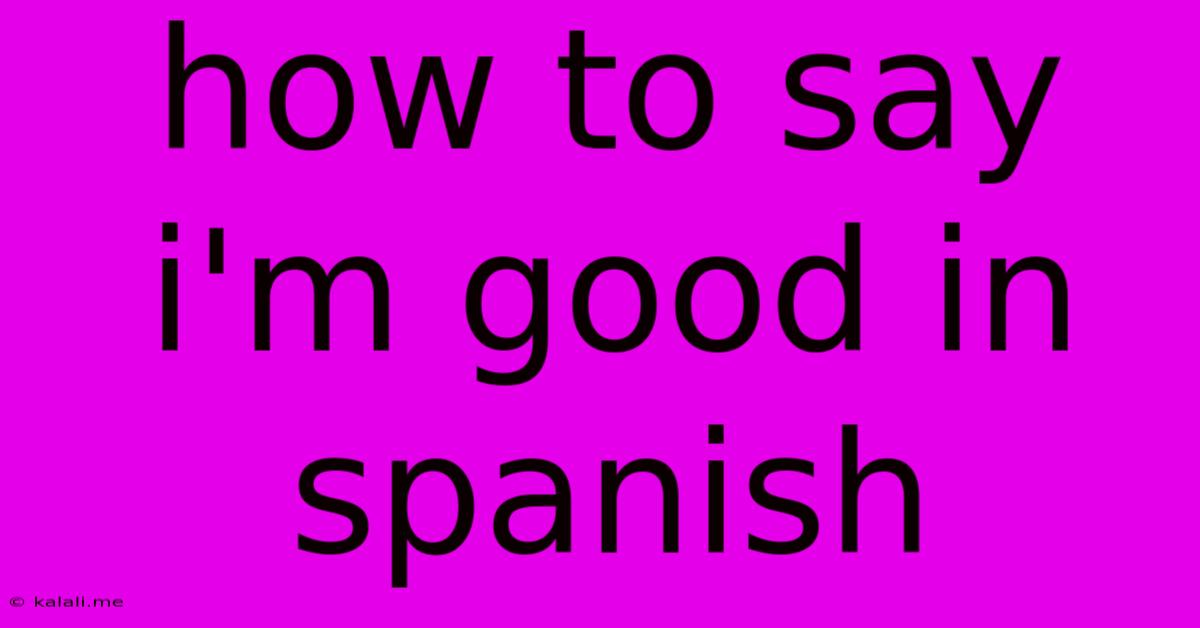How To Say I'm Good In Spanish
Kalali
Jun 07, 2025 · 3 min read

Table of Contents
How to Say "I'm Good" in Spanish: More Than Just "Bien"
So, you want to know how to say "I'm good" in Spanish? While the most straightforward translation is "bien," it's far from the only way to express this common sentiment. This article delves into the nuances of expressing well-being in Spanish, offering various phrases and contexts to help you sound more natural and fluent. Understanding the subtle differences will significantly improve your communication skills.
The most basic and common way to say "I'm good" in Spanish is "Estoy bien." This translates literally to "I am well," and it's perfectly acceptable in most situations. However, depending on the context and the level of formality, other options are more appropriate.
Beyond "Estoy Bien": Exploring Nuances of Well-being
While "Estoy bien" covers the basics, consider these alternatives for a more nuanced expression:
-
"Estoy muy bien," meaning "I'm very well," expresses a higher degree of well-being. This is a great option if you want to emphasize your positive feeling.
-
"Estoy bastante bien," translating to "I'm pretty well," is a slightly less enthusiastic but still positive response. This is a good choice for a more casual setting.
-
"Estoy genial," meaning "I'm great" or "I'm fantastic," conveys a strong sense of positivity and excitement. Use this when you're feeling truly amazing!
-
"Estoy de maravilla," meaning "I'm wonderful" or "I'm doing wonderfully," is a more formal and emphatic way to express excellent well-being.
-
"Estoy estupendamente," similar to "de maravilla," expresses a high level of well-being in a formal setting.
Context Matters: Responding to Specific Questions
The best way to say "I'm good" often depends on the question asked. For example:
-
"¿Cómo estás?" (How are you? - informal): This calls for a casual response like "Estoy bien," "Estoy bastante bien," or even "Estoy genial," depending on your mood.
-
"¿Cómo está?" (How are you? - formal): A formal greeting requires a more formal response such as "Estoy bien," "Estoy muy bien," "Estoy de maravilla," or "Estoy estupendamente."
-
"¿Qué tal?" (What's up? / How's it going?): This informal greeting allows for more flexibility. You could use "Bien," "Genial," or even a more detailed answer about your day.
-
"¿Cómo te va?" (How's it going?): Another informal option, similar to "¿Qué tal?" allowing for brief or more detailed answers.
Going Beyond Physical Health: Expressing Well-being Holistically
Remember that "bien" doesn't only refer to physical health. It encompasses overall well-being. If someone asks "¿Cómo estás?" and you're having a good day, you can confidently use these phrases. However, if you're feeling stressed or overwhelmed, you might want to use a more nuanced response. Consider these alternatives:
-
"Más o menos" (So-so): A neutral response indicating neither good nor bad.
-
"Regular" (Okay/So-so): Similar to "más o menos," but slightly more negative.
-
"No muy bien" (Not very well): Use this if you're not feeling your best.
Mastering these variations will elevate your Spanish conversations. Remember to practice and pay attention to the context to choose the most appropriate response. By understanding the nuances of expressing well-being, you'll communicate more effectively and sound more natural in Spanish.
Latest Posts
Latest Posts
-
How Do We Know If We Are Elect Westminster
Jun 08, 2025
-
How To Get Squirrel Out Of Attic
Jun 08, 2025
-
Looking Forward To Meeting You Soon
Jun 08, 2025
-
Weight Of A Cubic Foot Of Water
Jun 08, 2025
-
One Bulk Request Vs Multiple Reques
Jun 08, 2025
Related Post
Thank you for visiting our website which covers about How To Say I'm Good In Spanish . We hope the information provided has been useful to you. Feel free to contact us if you have any questions or need further assistance. See you next time and don't miss to bookmark.